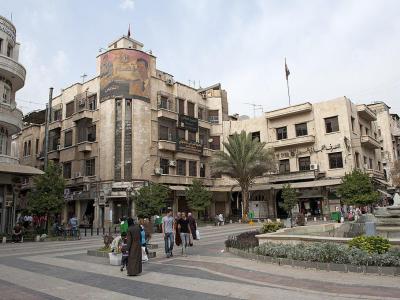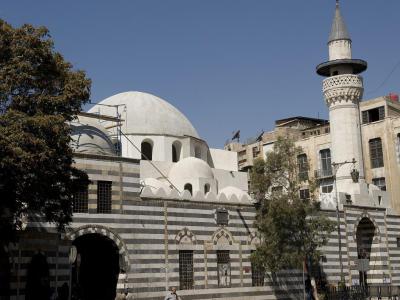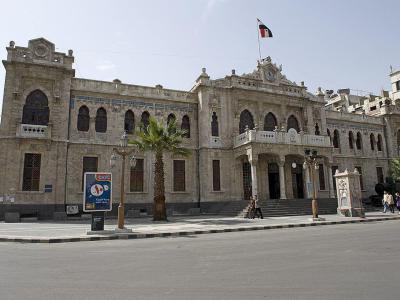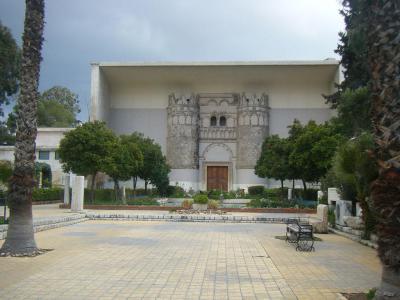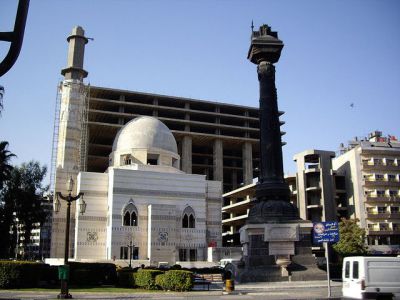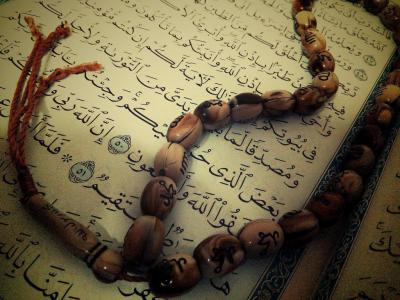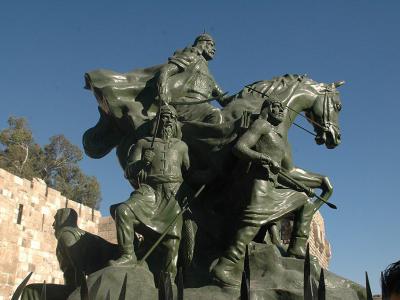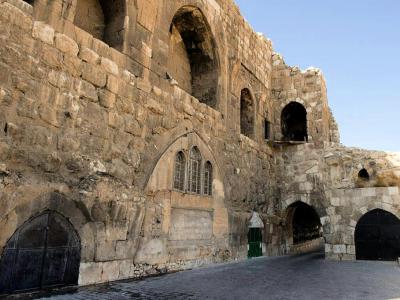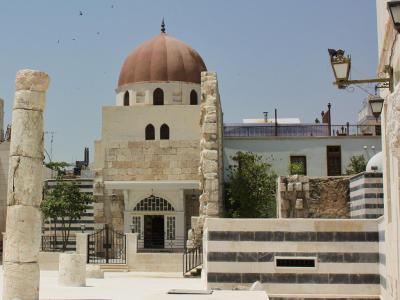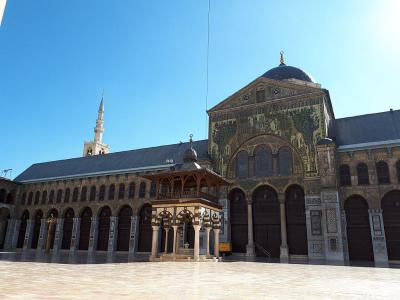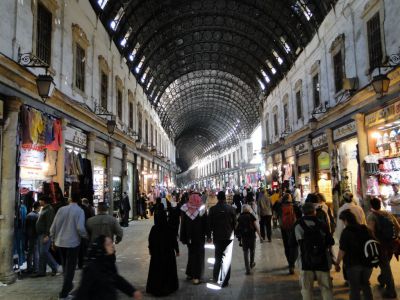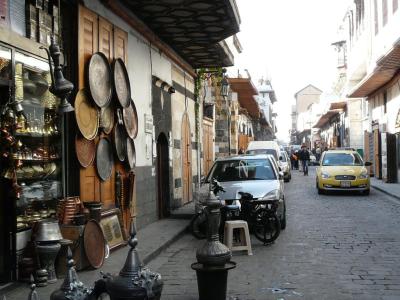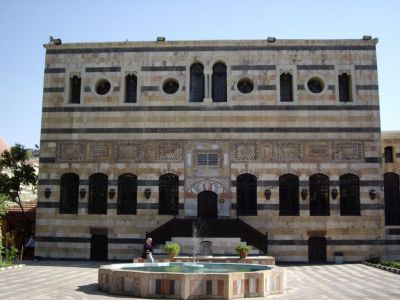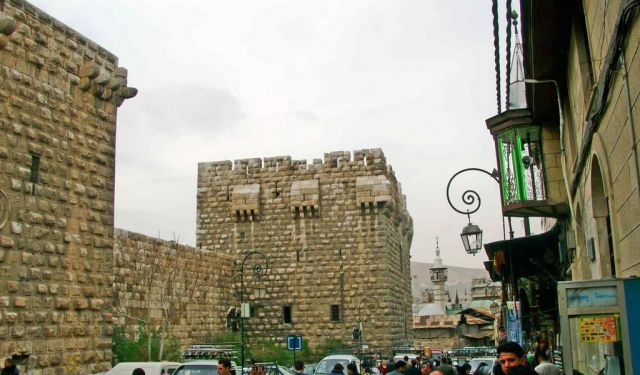
Damascus Introduction Walking Tour (Self Guided), Damascus
Damascus is the capital and currently the largest city of Syria, commonly referred to by the locals as “ash-Sham” and nicknamed “the City of Jasmine.” Today the city represents a blend of modern and ancient architecture, in which the latter is very carefully preserved and respected. Follow this orientation walk to explore some of the key historic sights of centuries-old Damascus.
How it works: Download the app "GPSmyCity: Walks in 1K+ Cities" from Apple App Store or Google Play Store to your mobile phone or tablet. The app turns your mobile device into a personal tour guide and its built-in GPS navigation functions guide you from one tour stop to next. The app works offline, so no data plan is needed when traveling abroad.
Damascus Introduction Walking Tour Map
Guide Name: Damascus Introduction Walking Tour
Guide Location: Syria » Damascus (See other walking tours in Damascus)
Guide Type: Self-guided Walking Tour (Sightseeing)
# of Attractions: 13
Tour Duration: 3 Hour(s)
Travel Distance: 4.3 Km or 2.7 Miles
Author: leticia
Sight(s) Featured in This Guide:
Guide Location: Syria » Damascus (See other walking tours in Damascus)
Guide Type: Self-guided Walking Tour (Sightseeing)
# of Attractions: 13
Tour Duration: 3 Hour(s)
Travel Distance: 4.3 Km or 2.7 Miles
Author: leticia
Sight(s) Featured in This Guide:
- Al Harikah Square
- Darwish Pasha Mosque
- Hejaz Railway Station
- National Museum of Damascus
- Yalboogha Mosque
- Mamluk Tengiz's Mosque
- Statue of Saladin
- Damascus Citadel
- Saladin's Mausoleum
- Umayyad Mosque
- Al-Hamidiyah Souq
- Damascus Straight Street
- Azm Palace
1) Al Harikah Square
Al Harikah Square is a famous commercial square that houses a number of shops and a beautiful fountain in its center. It had been a residential area up until it was bombed by the French military.
2) Darwish Pasha Mosque
The Darwish Pasha Mosque is an early Ottoman-era mosque in Damascus located along the Street Called Straight. The mosque was erected in 1574 by the Ottoman governor of Damascus Darwish Pasha. The building is built with alternating courses of black and white stones and is composed of a prayer hall preceded by a portico and a rectangular courtyard. On each side of the portal arch are two medallions of polychrome stone. The cylindrical minaret, crowned by a conical roof above a single balcony supported on muqarnas corbels, rises directly above the portal and is accessed by a spiral staircase entered from the courtyard. To the south side of the courtyard, is the five bay portico of the prayer hall. Its domes are carried on white stone columns with black capitals. Doorways at the east and west ends of the portico lead out to the streets.
The prayer hall is accessed through a door centered on the portico and flanked by windows with arched tympana. Adjoining the windows on both sides of the portico are three tile panels. The first panel on the east side is a tiled mihrab niche followed by a flat tiled panel depicting a niche. A similar panel is found on the west side of the entrance.
The prayer hall is accessed through a door centered on the portico and flanked by windows with arched tympana. Adjoining the windows on both sides of the portico are three tile panels. The first panel on the east side is a tiled mihrab niche followed by a flat tiled panel depicting a niche. A similar panel is found on the west side of the entrance.
Sight description based on Wikipedia.
3) Hejaz Railway Station (must see)
The Hejaz Railway was a narrow gauge railway that ran from Damascus to Medina, through the Hejaz region of Saudi Arabia, with a branch line to Haifa on the Mediterranean Sea. It was a part of the Ottoman railway network and was built to extend the line from the Haydarpaşa Terminal in Istanbul beyond Damascus to the holy city of Mecca. It got no further than Medina, 400 kilometres short of Mecca, due to the interruption of the construction works caused by the outbreak of World War I.
The main purpose of the railway was to establish a connection between Constantinople, the capital of the Ottoman Empire and the seat of the Islamic Caliphate, and Hejaz in Arabia, the site of the holiest shrines of Islam and the holy city of Mecca, the destination of the Hajj annual pilgrimage. Another important reason was to improve the economic and political integration of the distant Arabian provinces into the Ottoman state, and to facilitate the transportation of military forces. The railway is remarkable both for having had no debt when completed and for having many miles of track below sea level.
The main purpose of the railway was to establish a connection between Constantinople, the capital of the Ottoman Empire and the seat of the Islamic Caliphate, and Hejaz in Arabia, the site of the holiest shrines of Islam and the holy city of Mecca, the destination of the Hajj annual pilgrimage. Another important reason was to improve the economic and political integration of the distant Arabian provinces into the Ottoman state, and to facilitate the transportation of military forces. The railway is remarkable both for having had no debt when completed and for having many miles of track below sea level.
Sight description based on Wikipedia.
4) National Museum of Damascus (must see)
The National Museum of Damascus is a large museum in the heart of Damascus. It was founded in 1919 at Madrasseh al Adiliyeh. The current building was constructed in 1936, with wings being added in 1956 and 1975.
The exhibits are organised into 5 wings: Prehistoric Age (Remains and skeletons from different Stone-Age periods); Ancient Syria (Many Exhibits from ancient sites such as Ebla. The most important of these is the world's first Alphabet); Classical Age (This wing contains Roman, Greek and Byzantine exhibits. It includes many rare statues, as well as stone and marble sarcophagi. It also includes a jewellery section, and many other exhibits which may not be found in any other part of the world); Islamic Age (The facade of an Islamic palace has been moved and reconstructed as the museum's main entrance. Some of the contents of the palace are also located in the museum, including carvings.
It also contains many exhibits made of glass and metal, as well as coins, from different periods of Islamic History. There are also scriptures from the Ummayad era to the Ottomans.
The exhibits are organised into 5 wings: Prehistoric Age (Remains and skeletons from different Stone-Age periods); Ancient Syria (Many Exhibits from ancient sites such as Ebla. The most important of these is the world's first Alphabet); Classical Age (This wing contains Roman, Greek and Byzantine exhibits. It includes many rare statues, as well as stone and marble sarcophagi. It also includes a jewellery section, and many other exhibits which may not be found in any other part of the world); Islamic Age (The facade of an Islamic palace has been moved and reconstructed as the museum's main entrance. Some of the contents of the palace are also located in the museum, including carvings.
It also contains many exhibits made of glass and metal, as well as coins, from different periods of Islamic History. There are also scriptures from the Ummayad era to the Ottomans.
Sight description based on Wikipedia.
5) Yalboogha Mosque
The Yalbugha Mosque, built in 1264, was a Mamluk construction located along the Barada River, overlooking Marjeh Square. It was one of the most famous, influential and beautiful mosques in Damascus, and served as a resting point of the Hajj caravan. It took its name from Yalbugha, the governor of Damascus, who restored it in 1443. The ancient mosque was demolished in 1975 and replaced by a larger one bearing the same name. The new mosque remains unfinished due to its uneven settlement.
Sight description based on Wikipedia.
6) Mamluk Tengiz's Mosque
Mamluk Tengiz's Mosque is a beautiful mosque located on the city’s main street, Al Nasr Boulevard. This religious building also houses the tomb of its founder and great Mamluk governor, Prince Tankaz.
7) Statue of Saladin (must see)
The Statue of Saladin, a bronze statue depicting the Kurdish Ayyubid Sultan Saladin, is located in front of the Citadel of Damascus. Designed by Syrian sculptor Abdallah al-Sayed, it was unveiled by the late Syrian president Hafez Assad in 1993 to mark the 800th anniversary of Saladin's death. The statue, which graces the main plaza of the city, depicts Saladin in the same pose and the same dress as he appears in a number of 19th-century Western depictions of the Crusades. On each side of Saladin's horse stand two soldiers and a Sufi. Behind the horse, two crusaders, Guy of Lusignan and Raynald of Châtillon, kneel. According to the sculptor, Saladin appears not as an individual warrior but as a leader embodying a wave of popular feeling against the Franks.
Sight description based on Wikipedia.
8) Damascus Citadel (must see)
The Citadel of Damascus is a large medieval fortified palace. It is part of the Ancient City of Damascus, which was listed as a UNESCO World Heritage Site in 1979. The location of the current citadel was first fortified in 1076 by the Turkman warlord Atsiz bin Uvak. After the assassination of Atsiz bin Uvak, the project was finished by the Seljuq ruler Tutush I. The emirs of the subsequent Burid and Zengid dynasties carried out modifications and added new structures to it. During this period, the citadel and the city were besieged several times by Crusader and Muslim armies. In 1174, the citadel was captured by Saladin, the Ayyubid sultan of Egypt, who made it his residence and had the defences and residential buildings modified.
The citadel is located in the northwest corner of the city walls, between the Bab al-Faradis and the Bab al-Jabiyah. The citadel consists of a more or less rectangular curtain wall enclosing an area of 230 by 150 metres (750 by 490 ft). The walls were originally protected by 14 massive towers, but today only 12 remain. The citadel has gates on its northern, western and eastern flanks. The current citadel dates primarily to the Ayyubid period while incorporating parts of the older Seljuq fortress. Extensive repairs in response to sieges and earthquakes were carried out in the Mamluk and Ottoman periods.
The citadel is located in the northwest corner of the city walls, between the Bab al-Faradis and the Bab al-Jabiyah. The citadel consists of a more or less rectangular curtain wall enclosing an area of 230 by 150 metres (750 by 490 ft). The walls were originally protected by 14 massive towers, but today only 12 remain. The citadel has gates on its northern, western and eastern flanks. The current citadel dates primarily to the Ayyubid period while incorporating parts of the older Seljuq fortress. Extensive repairs in response to sieges and earthquakes were carried out in the Mamluk and Ottoman periods.
Sight description based on Wikipedia.
9) Saladin's Mausoleum (must see)
The Mausoleum of Saladin holds the resting place and grave of the medieval Ayyubid Sultan Saladin. It is located next to the northwest corner of the Umayyad Mosque in Damascus. The mausoleum was built in 1196, three years after the death of Saladin. It was once part of the al-Aziziyah madrasah, but nothing remains of the school.
It was originally built by Saladin's son, Al-Adil I. Saladin's body was interred temporarily at the Citadel of Damascus until the construction of the building was completed in 1196. The madrasah was built later by Saladin's other son, Al-Aziz Uthman.
The mausoleum itself is rather small and modest. The main square chamber displays ablaq walls and holds four arches capped by a cupola. Drawing on its history, the interior shows a remarkable mix of Hohenzollern, Ayyubid and Ottoman architecture. The room holds two cenotaphs. The original one, a wooden tomb, richly decorated with geometric and astral patterns, holds Saladin's body. The second one, is a marble coffin which was a gift from Emperor Wilhelm II. The mausoleum also holds another chamber which is used for Quranic recitation, and is accessible from the eastern side, in addition to five smaller rooms along the northern side of the building.
It was originally built by Saladin's son, Al-Adil I. Saladin's body was interred temporarily at the Citadel of Damascus until the construction of the building was completed in 1196. The madrasah was built later by Saladin's other son, Al-Aziz Uthman.
The mausoleum itself is rather small and modest. The main square chamber displays ablaq walls and holds four arches capped by a cupola. Drawing on its history, the interior shows a remarkable mix of Hohenzollern, Ayyubid and Ottoman architecture. The room holds two cenotaphs. The original one, a wooden tomb, richly decorated with geometric and astral patterns, holds Saladin's body. The second one, is a marble coffin which was a gift from Emperor Wilhelm II. The mausoleum also holds another chamber which is used for Quranic recitation, and is accessible from the eastern side, in addition to five smaller rooms along the northern side of the building.
Sight description based on Wikipedia.
10) Umayyad Mosque (must see)
The Umayyad Mosque, also known as the Great Mosque of Damascus or formerly the Basilica of Saint John the Baptist, located in the old city of Damascus, is one of the largest and oldest mosques in the world. It is considered the fourth-holiest place in Islam.
After the Arab conquest of Damascus in 634, the mosque was built on the site of a Christian basilica dedicated to John the Baptist (Yahya). The mosque holds a shrine which today may still contain the head of John the Baptist, honored as a prophet by both Christians and Muslims alike, and the place where Isa (Jesus) will return at the End of Days. The tomb of Saladin stands in a small garden adjoining the north wall of the mosque.
After the Arab conquest of Damascus in 634, the mosque was built on the site of a Christian basilica dedicated to John the Baptist (Yahya). The mosque holds a shrine which today may still contain the head of John the Baptist, honored as a prophet by both Christians and Muslims alike, and the place where Isa (Jesus) will return at the End of Days. The tomb of Saladin stands in a small garden adjoining the north wall of the mosque.
Sight description based on Wikipedia.
11) Al-Hamidiyah Souq (must see)
Al-Hamidiyah Souq, located near the Citadel, is a great open-air market. It stretches from Al-Thawra Street to the Umayyad Mosque and is the largest souq in Syria.
12) Damascus Straight Street (must see)
The Street Called Straight in the New Testament, or Damascus Straight Street is the Roman street (Decumanus Maximus) which runs from east to west in the old city of Damascus, Syria. It was visited by Paul the Apostle as recorded in the Acts of the Apostles.
Sight description based on Wikipedia.
13) Azm Palace (must see)
Azm Palace is a palace in Damascus, which was originally built in 1750 as a residence for the Ottoman governor of Damascus As'ad Pasha al-Azm. The palace now houses the Museum of Arts and Popular Traditions.
The architecture is an excellent example of Damascene traditional houses. The structure itself consists of several buildings and two wings: the harem and the salamlik. The harem is the family wing, which was a private space for the residents (originally, the Azm family). This wing includes the kitchen, servant quarters, and the baths, which are a replica of the public baths in the city but on a smaller scale. The salamlik is the guest wing, and it comprises the formal halls, reception areas and large courtyards with traditional cascading fountains.
In 1925, the Azm palace was heavily damaged by French artillery during the Syrian revolution. It has since been restored and became a museum of arts and folk traditions. It received the Aga Khan Award for Architecture in 1983.
The architecture is an excellent example of Damascene traditional houses. The structure itself consists of several buildings and two wings: the harem and the salamlik. The harem is the family wing, which was a private space for the residents (originally, the Azm family). This wing includes the kitchen, servant quarters, and the baths, which are a replica of the public baths in the city but on a smaller scale. The salamlik is the guest wing, and it comprises the formal halls, reception areas and large courtyards with traditional cascading fountains.
In 1925, the Azm palace was heavily damaged by French artillery during the Syrian revolution. It has since been restored and became a museum of arts and folk traditions. It received the Aga Khan Award for Architecture in 1983.
Sight description based on Wikipedia.
Walking Tours in Damascus, Syria
Create Your Own Walk in Damascus
Creating your own self-guided walk in Damascus is easy and fun. Choose the city attractions that you want to see and a walk route map will be created just for you. You can even set your hotel as the start point of the walk.
Old Damascus Landmarks Tour
Old Damascus has many precious historic landmarks that are full of mystery. The following self-guided tour will lead you to Damascus’ most amazing landmarks.
Tour Duration: 1 Hour(s)
Travel Distance: 0.9 Km or 0.6 Miles
Tour Duration: 1 Hour(s)
Travel Distance: 0.9 Km or 0.6 Miles
The Most Popular Cities
/ view all
